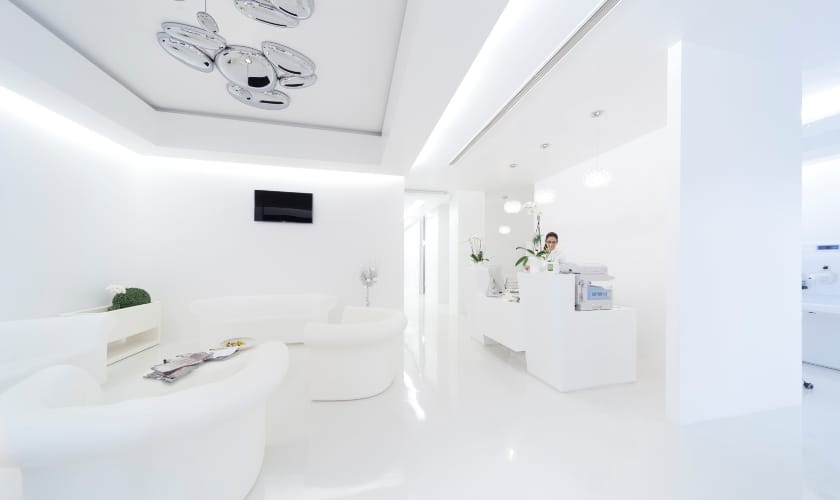
The Dos and Don’ts of Medical Office Interior Design: Creating a Welcoming and Functional Space
The traditional medical office with sterile, white walls is outdated. Today’s patients seek a healthcare experience that emphasizes their medical requirements as well as their comfort and overall well-being. Consequently, intentional medical office interior design is now essential for making a favorable impact and building trust.
Here, we delve into the dos and don’ts of medical office interior design, helping you navigate the process of creating a space that’s both inviting and functional:
Do: Prioritize Patient Comfort and Privacy
- Create a Welcoming Atmosphere: Move away from harsh clinical vibes. Opt for soft, calming colors, comfortable furniture, and natural light. Consider incorporating artwork or nature-inspired elements to create a more inviting ambiance.
- Respect Patient Privacy: Ensure exam rooms have soundproof doors and adequate space for confidential discussions. Design reception areas with separate stations for check-in to prevent sensitive information from being overheard.
- Cater to Accessibility Needs: Make your office accessible to people with disabilities. This includes incorporating ramps, wider doorways, grab bars in restrooms, and lowered counters for reception areas.
Don’t: Forget the Functionality of the Staff
- Optimize Workflow: While prioritizing aesthetics is important, don’t lose sight of functionality for staff. Design a layout that promotes efficient patient flow, with designated areas for waiting, consultations, examinations, and administrative tasks.
- Ensure Proper Storage: Provide ample storage solutions for medical supplies, equipment, and patient files. This helps maintain a clutter-free environment and promotes staff efficiency.
- Consider Staff Comfort: Invest in ergonomic furniture for staff workstations to prevent discomfort and fatigue, especially for those with prolonged computer use.
Do: Embrace Technology for a Streamlined Experience
- Self-Service Options: Implement self-service kiosks for patients to check in, update information, and even schedule appointments. This frees up valuable staff time and reduces wait times.
- Digital Signage: Utilize digital displays in the waiting area for appointment wait times, patient education videos, or health information.
- Telemedicine Integration: Offer telemedicine appointments for patients who prefer the convenience of remote consultations. This can be particularly beneficial for follow-up appointments or consultations for non-critical issues.
Don’t: Neglect Cybersecurity Measures
- Data Security is Paramount: In today’s digital age, robust cybersecurity measures are essential. Implement strong passwords, employee training on data security protocols, and secure data storage solutions.
- Maintain Patient Confidentiality: Ensure all digital displays and kiosks comply with HIPAA regulations to protect patient privacy.
Do: Create a Sensory-Friendly Environment
- Lighting Matters: Use a combination of natural and adjustable artificial lighting. Consider dimmable lights in exam rooms for a more calming atmosphere during consultations.
- Manage Noise Levels: Incorporate soundproofing materials in walls and ceilings to minimize noise distractions and create a sense of tranquility.
- Clear Wayfinding: Provide clear signage and visual cues to guide patients through your office. Consider color-coding different areas or using easily identifiable landmarks to make navigation intuitive.
Don’t: Underestimate the Power of Biophilic Design
- Embrace Nature’s Benefits: Studies show that incorporating elements of nature can significantly reduce stress and anxiety. Strategically placed plants purify the air, reduce noise, and create a sense of calm. Opt for low-maintenance varieties that thrive indoors.
- Harness Natural Light: Maximize the use of natural light with ample windows and skylights. This not only brightens the space but also provides a connection to the outdoors, fostering a sense of well-being.
- Nature-Inspired Elements: Consider incorporating calming water features, natural textures like wood and stone, or calming color palettes that reflect the serenity of nature (think light blues, greens, and browns).
By adhering to these guidelines, you can develop a medical office interior design that is both practical for your staff and inviting and soothing for your patients. Keep in mind that a thoughtfully planned environment can greatly enhance the overall healthcare journey, building trust and enhancing patient comfort. A carefully planned setting can play a key role in shaping a favorable medical experience for both young patients and their caregivers. Collaborate with Domani Development Inc., The Modern Dentist Homer Glen, for top-notch medical office construction and designs. Their medical office builder’s team offers professional services to realize your concept with exceptional quality and accuracy.

